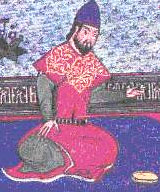| Malik-Shah I | |
|---|---|
 Investiture scene of Malik-Shah I, from the 14th-century book Jami' al-tawarikh | |
| Sultan of the Great Seljuk Empire | |
| Reign | 15 December 1072 – 19 November 1092 |
| Predecessor | Alp Arslan |
| Successor | Mahmud I |
| Born | 16 August 1055 Isfahan, Seljuk Empire |
| Died | 19 November 1092 (aged 37) Baghdad, Seljuk Empire |
| Burial | Isfahan |
| Spouse |
|
| Issue |
|
| House | Seljuk |
| Father | Alp Arslan |
| Religion | Sunni Islam |
Malik-Shah I (Persian: ملک شاه) was the third sultan of the Seljuk Empire from 1072 to 1092, under whom the sultanate reached the zenith of its power and influence.[3]

During his youth, he spent his time participating in the campaigns of his father Alp Arslan, along with the latter's vizier Nizam al-Mulk. During one such campaign in 1072, Alp Arslan was fatally wounded and died only a few days later. After that, Malik-Shah was crowned as the new sultan of the empire, but the succession was contested by his uncle Qavurt. Although Malik-Shah was the nominal head of the Seljuk state, Nizam al-Mulk held near absolute power during his reign.[4] Malik-Shah spent the rest of his reign waging war against the Karakhanids to the east and establishing order in the Caucasus.
The cause of Malik-Shah's death remains under dispute to this day; according to some scholars, he was poisoned by Abbasid caliph al-Muqtadi, while others say that he was poisoned by the supporters of Nizam al-Mulk.
- ^ Henry Melvill Gwatkin (1923). The Cambridge Medieval History: The Eastern Roman empire (717-1453). p. 307.
Malik Shāh was recognised by the Caliph as his successor, and invested with the title of 'Amir-al-Mu'minin
- ^ Massignon 1982, p. 162.
- ^ Tucker, Spencer C., ed. (2019). Middle East Conflicts from Ancient Egypt to the 21st Century: An Encyclopedia and Document Collection. Volume 1. Greenwood Publishing Group. p. 790. ISBN 978-1-440-85353-1.
- ^ Gibb, H. A. R. (1960–1985). The Encyclopedia of Islam, vol. 8. Leiden: Brill. p. 70.